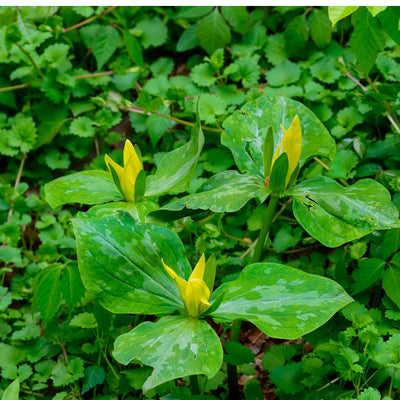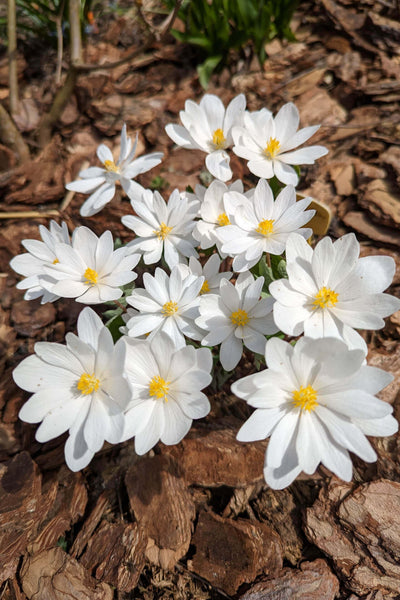A Guide to Fall and Winter Blooming Wildflowers
When most people think of wildflowers, they picture blooming in sun-drenched meadows during spring. But the marvels of wildflowers don’t vanish as thermometers drop; many varieties break into fall color and even progress to winter, beautifying gardens and wild spaces.
If you’re looking for a method to prolong your garden’s beauty, attract local wildlife, and reduce work, fall as well as winter blooming wildflowers offer splendid, environmentally friendly solutions.
In this post, you will learn not only which wildflowers bloom during these cooler months but also why it’s beneficial to plant them, how to grow them yourself, and where you can procure the best native varieties—plus answers to some common questions. And we cordially invite you to explore TN Nursery today!
Why Choose Fall and Winter Blooming Wildflowers?
A great deal of bird and insect food can come from these plants living long after surroundings have been remade by humans instead. Non-native ornamentals drain more water than the indigenous species, demand greater amounts of care and in times of want—such as when food is scarce for birds or bees—destroy your environment.
On the other hand, wildflowers adapt readily to whatever climate meta can throw at them. They find their share easier with less water and management on your part. What does this mean in real terms? Native wildflowers help your ecosystem out by feeding the local birds, bees, and butterflies during winter months when there is nothing else available.
For property owners, fall and winter blooming wildflowers provide their own resurgence. Starting in September and continuing until February, you can get a whole new spectrum of color that draws out the textures in your landscape year-buffer.
Top Fall and Winter Blooming Wildflowers
Let’s point up some of the wildflowers everyone feels gets better as the show goes on:
Trilliums
Another true standout among fall wildflowers, the Trillium sports its elegant three-petaled blossoms in shades of white, pinks, and reds. Woodland natives as well as shade and moist, rich soil seekers, Trilliums are perennial, long-lived cold weather plants perfect for cool spring weekends spent outside. They are the special symbol of autumn forests' floors: Their unique structure and bright coloring bring happiness to beneficial insects. Butterfly-catchers on view for everyone who enters the woods in autumn.
Gaillardia (Blanket Flower)
Blanket Flower blooms from summer to the first frosts with its bright red and gold petals. These tough natives thrive in poor soils, need little water other than what they can get from rooftops or the cracks between patio bricks, sun and flourish into fall as wildflowers that attract color even after most others have faded away. Butterflies like variety so plant them!
Bloodroot
Bloodroot is an enchanting wildflower that often begins blooming in late winter, heralding the coming of spring. It looks great against dark backgrounds of trees. Rising from the dead leaves of last year, where there was not yet any growth by the middle of March, it contrasts nicely with other colors in this season. Bloodroot is easy to look after and grows well in shaded, moist woodlands—perfect for planting beneath trees or stretching out along garden paths.
Ajuga
Ajuga, commonly known as Bugleweed, is a popular groundcover wildflower recognized for its dense foliage and spikes of blue, purple, or pink flowers. Bugleweed flower spikes in blue, purple, or pink colors, and the perennial with semi-evergreen leaves is often praised for providing vertical features and dense ground coverage. As it often blooms in the cooler seasons, it is a major food source and late-season nectar provider for important pollinators. Ajuga wildflower grew in popularity thanks to being a weed suppressor, and is also introduced as an aesthetic flower bed fueler..
Geraniums (Wild/Native Types)
Into fall, native geraniums keep borders and naturalized beds bright with their cheerful five-petaled blooms. An invigorating sight that lingers behind well into autumn, the sturdy and stalwart geranium thrives in many soils and blooms after some other annuals have been defeated.
Fall and winter, another mention should be aster flower, aster is the star-shaped flower which can resist cold until the first frost appears; goldenrod plants have tall stems full of gold real flowers; while mayapple plant sprouts in fall, sending its umbrella leaf up over the earth's surface and then blossoming toward late autumn. This all combines not only to make the countryside more picturesque, but each part contributes color, wildlife habitat, and soil health as well.
How to Grow Fall and Winter Wildflowers
Planting wildflowers is simple and rewarding. Most fall and winter bloomers are perennial; over time they establish themselves and bloom every year. Here are some steps to get started:
-
Location: Choose a sunny to partially-shaded site with well-drained soil, matching the native habitats of the wildflowers.
-
Soil Preparation: Remove weeds and break up the soil. Wildflowers are adaptable, but a good start is appreciated!
-
Seeds or plugs: For many species, you can sow seeds directly in late fall—allowing natural cold stratification (which old-fashioned winters provided)—or go to a garden center for nursery-grown plugs to get a jump on next season’s flowers.
-
Watering: Water well after planting. Once established, most native species need little additional water.
-
Maintenance: In general, leave withered stems for winter interest and wildlife habitat, then cut them back in early spring.
Other Plants
To extend the show into other seasons, you might also consider planting:
-
Witch Hazel: Even in snow, this fragrant yellow flower will bloom.
-
Hellebores (Lenten Rose): Early winter blooms of mauve, green, and white.
-
Camellias: Colorful winter shrubs.
-
Winter Jasmine: Yellow flowers on bare branches in late winter.
So combine these with wildflowers for interest all year round.
Where to Buy Wildflowers and Native Plants
Finding native wildflowers is a tough task at big-box stores. But online nurseries, especially TN Nursery, provide all kinds of wildflower seeds and plants that are perfect for fall or winter gardens. TN Nursery also offers many heirloom varieties. These are disease-resistant, hardy, and sometimes difficult to find anywhere else in the modern world. For those keen on native plants and eco-friendly gardening, it has become the most important source.
TN Nursery Online: Changing the Look of Your Yard with Beauty 365 Days, 24 Hours
Ready to create a landscape that shines in every season? Visit TN Nursery for rare native plants as well as high-quality fall and winter blooming wildflowers or expert gardening advice on all things garden-related, he says. With an extensive online selection plus customer-focused service designed for those who care about what they buy as much as getting it done efficiently, discover how easy it really is to change your outdoor experience. Welcome color, wildlife, and joy into your outdoor space today no matter what the weather may hold.
FAQs
What flower blooms in fall and winter?
There are many native wildflowers that bloom in fall and winter, such as Blanket Flower, Asters, and some Camellias. These plants not only keep flower beds colorful during the colder seasons, but they also provide valuable food for pollinators.
Are there wildflowers that bloom in the fall?
Indeed. There are trilliums, blanket flowers, and asters, among others, that put on a beautiful fall display, providing wildlife with food and brightening landscapes even as temperatures fall.
Are there wildflowers that bloom in the fall
Yes, fall is often the best time to sow wildflower seeds. The winter weather helps them germinate naturally, and they usually come up sometime in spring—just be sure you prepare the soil first and keep it weed-free.
Are there any wildflowers that grow in winter?
Most wildflowers bloom in spring and fall against a backdrop of winter greenery. However, some, like Bloodroot and early blooming Ajuga, start flowering in late winter offering a sign of life when little else is in bloom.
Which plant gives 12 months of flowers?
Few plants bloom all through the year. However, by combining fall-blooming wildflowers with winter standouts like Hellebores and Witch Hazel, you can ensure 365 days of color in your garden.
What is the wildflower for October?
Often called "The Wildflower for October," asters roll out late-season, star-shaped blooms that make the garden come alive for another few weeks and bring towards those slow-moving targets and eggs in flight themselves.





